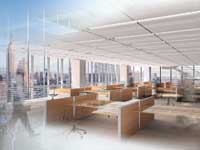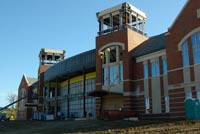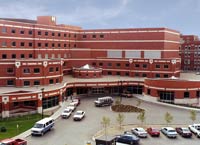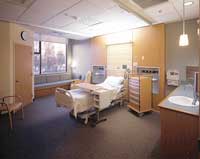view all Case Studies
Newspaper Publisher Specifies Innovative Lighting Solution

The New York Times Co. demanded innovation for its new headquarters and, after a rigorous testing process involving the Lawrence Berkeley National Laboratory (LBNL), selected Lutron’s EcoSystem lighting controls to help create an energizing work environment and reduce the building’s energy consumption.
February 14, 2008 -
Energy Efficiency
The New York Times Co. demanded innovation for its new headquarters and, after a rigorous testing process involving the Lawrence Berkeley National Laboratory (LBNL), selected Lutron’s EcoSystem lighting controls to help create an energizing work environment and reduce the building’s energy consumption.
EcoSystem controls were installed in 21 floors – about 625,00 square feet – occupied by the parent company of The New York Times in its 52-story office tower in Manhattan.
“We wanted a new headquarters that made a positive contribution to New York City,” says David Thurm, the New York Times Co.’s vice president and chief information officer. “We also desired an interior environment that allowed our employees to be as comfortable as possible and that would reinforce our company's emphasis on open communication, collaboration, and transparency. In addition, we insisted that the building be as environmentally friendly as possible.”
The publisher researched numerous lighting controls from a variety of manufacturers. The research eventually gravitated to the Building Technologies Department at the University of California-Berkeley’s LBNL. With guidance from the LBNL, the project-design team, and manufacturers, the publisher built a replica of the southwest corner of the new building at one of its printing facilities in College Point, N.Y.
For six months, from winter solstice to summer solstice, the mock-up tested an array of different lighting technologies and products from a variety of manufacturers, which led to the specification of the EcoSystem solution. EcoSystem employs a number of different strategies, including daylight sensing, occupant sensing, and precise dimming.
“The whole building structure is designed to maximize daylighting,” says Hussain Ali-Khan, the Times Co.’s vice president of real estate development. “The number one priority was to allow natural light to make our employees feel more comfortable and to produce an energizing work environment.”
With EcoSystem, the daylight sensors make the most of natural light pouring into a space, continually and imperceptibly adjusting the electric-light levels while maintaining a consistent overall light level for each space. This particular building requires a minimum amount of electric light to meet the target levels. Whenever the natural-light levels are greater than the target set point, the lights turn off.
“With all the daylight coming in, the avoidance of glare was a crucial issue to the client,” says Attila Uysal, principal and technical director of SBLD Studio, the lighting-design firm. “Lutron’s involvement from the beginning was invaluable.”
Due to EcoSystem’s digitally addressable ballast – about 15,000 of which were installed in this building – it easily adapts to changing office-design requirements with simple reprogramming.
“What we have achieved with our building is spectacular,” Ali-Khan says. “But any office space eventually needs to move in different directions, and this lighting system gives us the flexibility to change as we see fit.”
Next
Read next on FacilitiesNet












